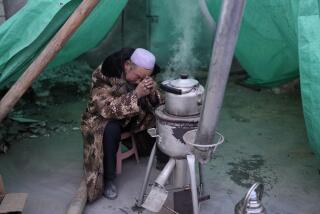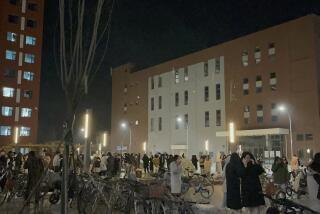Quake threatens a culture’s future
- Share via
BEICHUAN, CHINA — Deng Rufu sits on a rock watching the exodus of his people from their ravaged homeland.
A young Qiang man with a sweating brow carries his 82-year-old grandmother on a wooden contraption strapped to his back. Another elderly woman climbs painfully with a hand-carved walking stick. A little girl in pink sneakers lags behind the rest.
“At this point, we don’t know how many we’ve lost,” Deng said as he tapped on one of the few items he’d salvaged, a traditional sheepskin drum. “We need to protect our culture. There are very few Qiang people left.”
One of the many indiscriminate acts of last week’s massive earthquake was the destruction of the ancestral homeland of the Qiang, one of the more mysterious of China’s minorities. Described variously as descendants of a legendary 21st century BC Chinese emperor or a lost tribe of Israelites, the Qiang number only about 300,000. As their singular misfortune would have it, almost all lived within 100 miles of the earthquake’s epicenter, mainly in Sichuan province’s hardest-hit counties.
Qiang people fleeing through the mountains Saturday said they walked for 12 hours from a village in Beichuan County called Dengbao, where only two elderly people refused to leave.
“Houses, roads, our pigs, everything, absolutely everything, was destroyed,” said farmer Deng Kaijian, 33, as he hiked up the steep grade out of Beichuan with the others.
Some were seeing the outside world for the first time.
“We’ve never been out of our village before,” said Deng Jiachang, 68, who sat Tuesday beside his 65-year-old wife, Wu Guangfen, in a Mianyang aid camp, clutching coupons for instant noodles as though they were gold.
“I don’t know what we’ll do next,” added Deng, dressed in a blue jacket and traditional brown hat somewhat reminiscent of an oversized beret.
Ethnic maps of China show Qiang villages scattered roughly along the fault line of the magnitude 7.9 earthquake. Beichuan, a county where 80% of the buildings were destroyed, was home to as many as 90,000 Qiang. Wenchuan County, the epicenter, was home to an additional 30,000. A few minutes away is Taoping, a 2,000-year-old Qiang village of 3,000 people renowned for its ancient stone towers and block houses. The village reportedly sustained heavy damage.
Nobody will hazard a guess at this stage how many of the 40,000 confirmed earthquake victims were Qiang. Many of their mountain villages are so remote that more than a week later, rescue workers have yet to reach them.
As well, younger Qiang who worked or studied in larger towns wear Western clothing, like the majority Han Chinese, making it impossible for rescuers to easily distinguish Qiang victims from others. But there is no doubt that the Qiang received a disproportionate blow.
“It is the Qiang who were most severely hit,” said Huang Chenglong, a 40-year-old scholar and a Qiang from Mao County. The situation appears bleak, but there is at least some reason for hope. The Qiang’s traditional houses are sturdy buildings made of stone. The Qiang survived another killer earthquake in 1933 in Mao, about 50 miles away. Whatever else is in their tradition, they have long experience dealing with a zidum -- the Qiang word for earthquake.
On Sunday, Huang helped organize a gathering in Beijing of Qiang scholars and students to discuss how to help.
“The atmosphere was quite sad,” Huang said. “There were five or six students who hadn’t been able to get any word from their parents.”
Colleagues in Beichuan setting up a Qiang research center were killed when a county government building collapsed, he said.
“The earthquake not only reduces the population,” Huang said. “It will also have a destructive effect on the culture. During the rebuilding period, many people will move from their mountain communities to the big cities. This will present enormous difficulties for protecting their cultural identity.”
The Qiang’s identity already has question marks. They have some resemblance in physical appearance and culture to Tibetans, although they practice a pre-Buddhist animism, believing everything is imbued with spirits.
Their lineage is also under debate.
The official Chinese government line is that the Qiang are directly descended from Yu the Great, an almost mythical feature from the first recorded Chinese dynasty, and perhaps ancestors of the Chinese. Inscriptions found on ancient oracle bones refer to a Qiang people. This theory is convenient for the government in that it bolsters its claims to minority areas of western China.
Scottish missionary Thomas Torrance, on the other hand, wrote in the 1920s and ‘30s that they were descendants of ancient Israelites. He cited their abhorrence of idols and their custom of celebrating the New Year in autumn as it is on the Jewish calendar.
In Taiwan, scholar Wang Mingke has challenged both theories. He believes the term “Qiang” (the Chinese character for which suggests a shepherd) was used in old Chinese inscriptions to refer generically to the various nomadic peoples living to the west and has no direct relationship to today’s Qiang.
It has only been in recent decades that these people identified themselves as Qiang, he said.
“They were really made up of hundreds of small groups in every little valley. They’d refer to themselves as erma, which means ‘our people,’ and they would call the people over in the next valley the barbarians,” Wang said.
In recent years, there has been a growing interest in Qiang culture by scholars and tourists. Linguists at the Academia Sinica in Taipei have been compiling a lexicon of the Qiang language, which is part of the Tibeto-Burman group and is the most unifying factor among the various tribal groups in the valleys. It is no easy task given that Qiang has various dialects and no written form. Out of 300,000 Qiang, only about 100,000 speak the language.
Jonathan P. Evans, a linguist working on the lexicon, worries that many of those remaining speakers were killed in the earthquake. “I’ve been trying to call for days people I knew there, but I’m not getting through,” Evans said.
An even bigger danger than earthquakes may be assimilation. Fewer young people speak Qiang with any fluency.
“We speak Mandarin Chinese and don’t speak Qiang,” said Wang Guangmei, 34, at the Mianyang camp on Tuesday. “We’re not the mountain Qiang people. We pretty much follow the Chinese traditions for weddings and funerals.”
Even many older people don’t bother speaking it to their children.
“Everybody says they don’t like their culture passing away,” Evans said. “They want somebody to maintain the culture, but somebody else’s kid, not their own.”
--
barbara.demick@latimes.com
Magnier reported from Beichuan and Demick from Beijing. Gao Wenhuan of The Times’ Beijing Bureau contributed to this report.
More to Read
Sign up for Essential California
The most important California stories and recommendations in your inbox every morning.
You may occasionally receive promotional content from the Los Angeles Times.










